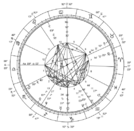Astrology software
Topic: Unsolved
 From HandWiki - Reading time: 4 min
From HandWiki - Reading time: 4 min
| Astrology |
|---|
| Background |
| Traditions |
| Branches |
Astrology software is a type of computer programs designed to calculate horoscopes. Many of them also assemble interpretive text into narrative reports.[1][2][3][4]
History
Astro Computing Services (ACS) in San Diego, founded by Neil Michelsen in 1973, published a computer-generated astrological ephemeris in 1976, The American Ephemeris.[5]
When personal computers generally became available, astrologers and astrology hobbyists were able to purchase them and use astrological or astronomical calculation software or make such programs themselves. Astrologer and computer programmer Michael Erlewine was involved early in making astrological software for microcomputers available to the general public in the late 1970s. In 1978, Erlewine founded Matrix Software, and in 1980 he published a book with all the algorithms and data required for owners of microcomputers to make their own complete astrological programs.[5] At first, astrology software was opposed by American astrologers who did not approve of computers in their field. However, acceptance grew as it became clear how more efficient and profitable such software could be.[5]
A few hundred fixed-purpose astrology computers were made, one of which was used by Nancy Reagan's astrologer beginning in about 1981.[6]
Astrology software has been made available in the open-source model, starting with the release of Astrolog in 1991.
Features
Computer astrology programs today typically make accurate planet position calculations, display and print these positions using astrological glyph symbols in graphic charts, save and retrieve individuals' data to and from database files, compare the planet positions of different charts to find the astrological aspects between them (e.g. for compatibility), calculate the dates of important events in the future for a chart, and research the saved chart database. Some generate colorful geographical maps with lines showing where the planets rise and culminate at a significant time, usually the time of birth or the time of inception of an organization (called astrocartography). Astrology programs usually come bundled with an electronic atlas, allowing the review of the longitudes, latitudes, and time zone observance histories for cities and towns.[7][8] Many assemble interpretive text about the various element combinations in a chart into comprehensive printed reports.[9]
See also
References
- ↑ Baronoff, Susan Marya (1992-04-16). "Technology Dawns on Age of Aquarius: Looking to Future of Profession, Astrologists at Trade Show See Computers—and Washington". The Washington Post. http://www.highbeam.com/doc/1P2-1001036.html.
- ↑ Mansfield, V. (December 1983). "Microastrology: Casting a Horoscope With a PC". PC Magazine 2 (7): 597–607. "Astrological techniques lend themselves to microcomputers because these computers can do the necessary calculating of planetary and house positions to at least one tenth of a degree. The difficulty arises when the computer is used for the interpretive and interactive phase of astrology.".
- ↑ Brimelow, P. (1984-05-28). "Heavens Help Us". Barron's; "The most important development for astrology today is the computer. Computers are able to easily perform the intricate calculations involved in drawing up a chart.".
- ↑ James H. Holden (August 2006), "Modern Astrology", History of Horoscopic Astrology, American Federation of Astrologers, pp. 184–227, ISBN 978-0-86690-463-6, https://books.google.com/books?id=9p1igGF3gpUC
- ↑ 5.0 5.1 5.2 Lewis, James R. (2003). The astrology book: the encyclopedia of heavenly influences. Visible Ink Press. ISBN 978-1-57859-144-2. https://books.google.com/books?id=lmv4930JbY0C&q=Astrology+Computer&pg=PA433.
- ↑ Dern, Daniel P. (July 2012). "Does Your Beloved Tech Artifact Belong in a Museum?" (in en). IEEE Spectrum. https://spectrum.ieee.org/at-work/innovation/does-your-beloved-tech-artifact-belong-in-a-museum.
- ↑ Foreman, Patricia L.; Peter Ashe (1992). Computers and Astrology: A Universal User's Guide and Reference. Good Earth Publications. pp. 304. ISBN 978-0-9624648-1-2.
- ↑ Friedman, Hank (1984). Astrology on Your Personal Computer. Sybex Inc.. pp. 225. ISBN 978-0-89588-226-4.
- ↑ Nine of the ten software programs reviewed by TopTenReviews.com in 2011 provide interpretive reports.
 |
 KSF
KSF

